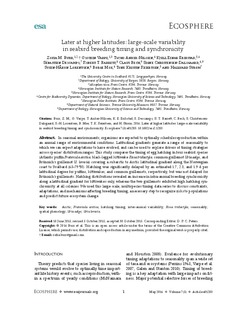Later at higher latitudes: large-scale variability in seabird breeding timing and synchronicity
| dc.contributor.author | Burr, Zofia M. | |
| dc.contributor.author | Varpe, Øystein | |
| dc.contributor.author | Anker-Nilssen, Tycho | |
| dc.contributor.author | Erikstad, Kjell E | |
| dc.contributor.author | Descamps, Sébastien | |
| dc.contributor.author | Barrett, Robert T | |
| dc.contributor.author | Bech, Claus | |
| dc.contributor.author | Christensen-Dalsgaard, Signe | |
| dc.contributor.author | Lorentsen, Svein-Håkon | |
| dc.contributor.author | Moe, Børge | |
| dc.contributor.author | Reiertsen, Tone Kristin | |
| dc.contributor.author | Strøm, Hallvard | |
| dc.date.accessioned | 2016-06-06T08:15:48Z | |
| dc.date.accessioned | 2016-06-07T12:37:54Z | |
| dc.date.available | 2016-06-06T08:15:48Z | |
| dc.date.available | 2016-06-07T12:37:54Z | |
| dc.date.issued | 2016 | |
| dc.identifier.citation | Ecosphere 2016, 7(5) | nb_NO |
| dc.identifier.issn | 2150-8925 | |
| dc.identifier.uri | http://hdl.handle.net/11250/2391727 | |
| dc.description.abstract | In seasonal environments, organisms are expected to optimally schedule reproduction within an annual range of environmental conditions. Latitudinal gradients generate a range of seasonality to which we can expect adaptations to have evolved, and can be used to explore drivers of timing strategies across species’ distribution ranges. This study compares the timing of egg hatching in four seabird species (Atlantic puffin Fratercula arctica, black-legged kittiwake Rissa tridactyla, common guillemot Uria aalge, and Brünnich’s guillemot U. lomvia) covering a subarctic to Arctic latitudinal gradient along the Norwegian coast to Svalbard (65–79°N). Hatching was significantly delayed by an estimated 1.7, 2.3, and 1.9 d per latitudinal degree for puffins, kittiwakes, and common guillemots, respectively, but was not delayed for Brünnich’s guillemots. Hatching distributions revealed an increase in intra-annual breeding synchronicity along a latitudinal gradient for kittiwakes only, whereas the two guillemots exhibited high hatching synchronicity at all colonies. We used this large-scale, multispecies timing data series to discuss constraints, adaptations, and mechanisms affecting breeding timing, a necessary step to recognize risks to populations and predict future ecosystem change. Arctic; Fratercula arctica; hatching timing; inter-annual variability; Rissa tridactyla; seasonality; spatial phenology; Uria aalge; Uria lomvia. Received | nb_NO |
| dc.language.iso | eng | nb_NO |
| dc.rights | Navngivelse-Ikkekommersiell-DelPåSammeVilkår 3.0 Norge | * |
| dc.rights.uri | http://creativecommons.org/licenses/by-nc-sa/3.0/no/ | * |
| dc.subject | Arctic | nb_NO |
| dc.subject | Fratercula arctica | nb_NO |
| dc.subject | hatching timing | nb_NO |
| dc.subject | Rissa tridactyla | nb_NO |
| dc.subject | seasonality | nb_NO |
| dc.subject | spatial phenology | nb_NO |
| dc.subject | Uria aalge | nb_NO |
| dc.subject | Uria lomvia | nb_NO |
| dc.subject | inter-annual variability | nb_NO |
| dc.title | Later at higher latitudes: large-scale variability in seabird breeding timing and synchronicity | nb_NO |
| dc.type | Peer reviewed | nb_NO |
| dc.type | Journal article | |
| dc.date.updated | 2016-06-06T08:15:48Z | |
| dc.source.volume | 7 | nb_NO |
| dc.source.journal | Ecosphere | nb_NO |
| dc.source.issue | 5 | nb_NO |
| dc.identifier.doi | 10.1002/ecs2.1283 | |
| dc.identifier.cristin | 1359716 |
Tilhørende fil(er)
Denne innførselen finnes i følgende samling(er)
-
Publikasjoner fra CRIStin - NINA [2364]
-
Scientific publications [1392]
Vitenskapelige artikler, kapitler og monografier i Open Access.

